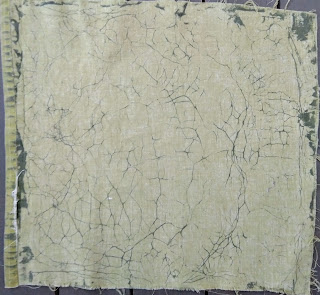This was a fun technique to try! I had never heard of it until our latest workshop leader on TextileArtist.org Stitch Club, Jette Clover, mentioned it. The effect gives a crackled pattern of colour which could inspire tree branches, maps, crumbling surfaces, blood and veins, delicate patterns of petals, lizard skin etc.
The basic technique is to make a simple flour and water paste and spread it on the fabric. When completely dry the paste is cracked and paint or dye added to seep into the cracks. Once the paste is washed out you are left with a unique piece of fabric.
First I chose my fabrics - a range of light and dark pieces of old sheets. They are about A4 size and laid out on a piece of plastic to protect my table.
Then it needs to dry thoroughly - I pegged mine to the radiator as I was doing this in winter!
You know when they are completely dry because they go hard and crispy, with the edges curling up in an extraordinary way.
Then the fun bit - cracking the paste! You can create as many or as few cracks as you like. Initially I didn't do many because I feared the paste would all fall off in tiny bits but it is actually really well behaved and you can crack it quite a lot. I ran some pieces over the back of a wooden chair to get a lot of cracks all the way along. The tutor, Jette, said that if you put your pasted fabric in the freezer for an hour you can get crisper cracks - I didn't try this as I was too impatient. I painted mine with slightly watered down acrylics and applied with a wide flat brush. You can of course use liquid fabric dye or paint.
This photo is the back of the piece above straight after painting. You can see some big blobs where I added a bit more water to the paint and went back over it so don't do this if you don't want this effect. It's a good idea to check the back to see that some of the paint is getting through the cracked paste.Once the paint is dry you can wash it out. I found that the acrylic paint put a sort of plasticky layer over the flour paste and made it quite easy to scrape off in big chunks. Make sure you so this in a washing up bowl and throw away the waste in the bin rather than down your sink.
Here are my results from this first experiment - really interesting I think. Jette also mentioned that you can use thick bleach on dark cotton to get a white crackle effect - do this outside with gloves and eye protection.
This was my favourite piece. I learned that thinner fabrics worked best, don't spread the paste too thinly and don't make the paint too watery.










